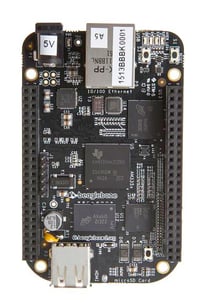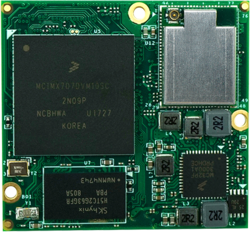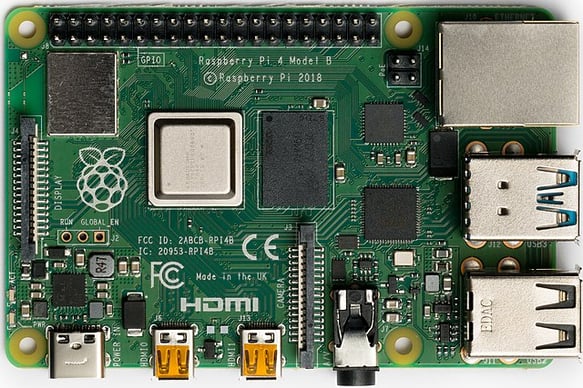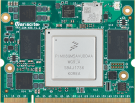Choosing the right IoT hardware for an IoT project is an important decision to make during the prototyping phase of an IoT product development. In this article, we highlight the top 5 IoT development boards used by Mender users across different industries, together with their technical specifications, summarized in a table.
Raspberry Pi 4 Model B
Raspberry Pi 4 is one of the most popular boards used both in professional environments as well as by people beginning their journey in the embedded world, that’s why it’s a must-have on a list of top 5 IoT development boards. It’s a low-cost, but quite powerful embedded board. RPi4 is equipped with a high-performance 64-bit quad-core processor - Broadcom BCM2711, which is a Cortex-A72 (ARM v8) 64-bit SoC. On top of it it is equipped with dual-display support, hardware video decode at up to 4Kp60, dual-band 2.4/5.0 GHz wireless LAN, Bluetooth 5.0, Gigabit Ethernet, USB 3.0, as well as PoE capability. Raspberry Pi 4 is one of the official reference devices of Mender. Take a look at our documentation on how to flash an SD card for Raspberry Pi and get started with OTA updates for Raspberry Pi 4.
NVIDIA Jetson Nano
.jpg?width=600&height=600&name=NVIDIA_Jetson_Nano_Developer_Kit_(47616885631).jpg)
NVIDIA Jetson Nano is a small, single-board computer designed for AI purposes. It’s both cost- and power-efficient. Nvidia Jetson Nano is equipped with 128-core NvidiaMaxwell GPU, a high-performing Cortex-A57 processor (ARM v8-A), and provides hardware video decoding capabilities at up to 4Kp60, similarly to RPi 4. Jetson Nano is also supported by NVIDIA JetPack, which includes a board support package (BSP), Linux OS, Nvidia CUDA, cuDNN, and TensorRT software libraries for deep learning, computer vision, speech processing, GPU computing, multimedia processing, and much more. This board is also supported by Mender. Learn how to deploy OTA updates to a NVIDIA Jetson Nano board.
BeagleBone Black

BeagleBone Black is yet another low-cost, single-board, and open-source computer suitable for both hobbyists, as well as experienced embedded engineers. Equipped with AM335x 1GHz ARM Cortex-A8 processor, 512MB of DDR3L DRAM, onboard micro HDMI port, 3D graphics accelerator, 4GB onboard flash memory, Beaglebone Black earned its place in our top 5 IoT development boards ranking. BeagleBone Black is perfect for physical computing and smaller embedded applications. In contrast to RPi it provides more GPIO ports so that you can connect more pheripherials out of the box. Read about Beaglebone Black’s integration with Mender.
Technexion PICO-PI-IMX7

PICO-PI-IMX7 is a highly-integrated embedded board produced by Google’s hardware partner Technexion. This single board computer is suitable for a variety of use cases, ranging from basic embedded devices to complex use cases. PICO-PI-IMX7 is equipped with an NXP i.MX 7Dual dual-core Cortex-A7 processor @ 1 GHz with Cortex-M4 real-time core, 512MB DDR3L, 4GB Wi-Fi, 802.11 ac & Bluetooth 4.1. It has been tested and proven to run Android Things, Linux, Yocto, Ubuntu, and Android at optimal performance. Watch a short video to learn how Mender integrates with Technexion hardware to enable secure and robust OTA updates.
Variscite VAR-SOM-MX8M-MINI : NXP i.MX 8M Mini
The VAR-SOM-MX8M-MINI is a System on Module (SoM) based on NXP’s i.MX 8M Mini with four powerful 64-bit Armv8 Cortex-A53 cores that offers an extensive variety of applications together with ultimate scalability options. This embedded board is equipped with 4.2 BT/BLE, Gigabit Ethernet, CAN bus, dual USB2.0 and LVDS. Additionally, the SoM provides an integrated HW engine supporting 1080p video encoding/decoding, 2D and 3D GPU, and high quality audio. Variscite also guarantees longevity and endurance in the hardest industrial use cases. Learn how to integrate this board with Mender.
Embedded boards technical specifications comparison
| Raspberry Pi 4 Model B | NVIDIA Jetson Nano | BeagleBone Black | Technexion PICO-PI-IMX7 | Variscite VAR-SOM-MX8M-MINI : NXP i.MX 8M Mini | |
| CPU | Broadcom BCM2711, quad-core Cortex-A72 (ARM v8) 64-bit SoC @ 1.5GHz | Quad-core ARM® Cortex®-A57 MPCore processor | AM335x 1GHz ARM® Cortex-A8 | NXP i.MX7 Dual | NXP i.MX 8M Mini and 400MHz Cortex-M4 co-processor |
| GPU | Broadcom VideoCore VI @ 500 MHz | NVIDIA Maxwell™ architecture with 128 NVIDIA CUDA® cores | PowerVR SGX530 | CSC Pixel Processing Pipeline | 1080p60 H.265/H.264/VP9 Decode, 1080p60 |
| Memory | 1GB, 2GB or 4GB LPDDR4 | 4 GB 64-bit LPDDR4 | 512MB DDR3 | Up to 1GB DDR3L | Up to 4GB GB of DDR4 |
| Power Source | 5V DC via USB-C Power over Ethernet (PoE)–enabled | 5V DC via USB-C | 5V from USB mini B connector, 2.1mm jack, or header pin | 5V DC via USB-C | Single 3.5-5V |
| Dimensions | 56.5 mm x 85.6 mm | 70 mm x 45 mm | 86.4 mm x 53.3 mm | 85 mm x 56 mm | 67.6 mm x 33.0 mm |
Which one from the top 5 IoT development boards is best?
In this article we listed top 5 IoT development boards used in modern IoT projects. They differ in terms of technical specifications and their purpose. Besides the ones listed, there are many other embedded boards out there, produced both by startup IoT hardware providers and large hardware manufacturers. All of the embedded boards listed in this article are supported and have a maintained integration with Mender. Sign up for the free trial of Mender Enterprise to test deploying OTA updates to your embedded Linux board.
Recent articles
The struggle to reach global markets for medical device manufacturers: The importance of international compliance
The differences between the US FDA’s device approval process and the EU’s medical device regulation (MDR): An essential dual-compliance framework for global manufacturers
Why OTA updates are now mission critical for future-proofed device lifecycle management
Learn why leading companies choose Mender
Discover how Mender empowers both you and your customers with secure and reliable over-the-air updates for IoT devices. Focus on your product, and benefit from specialized OTA expertise and best practices.






